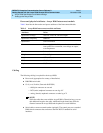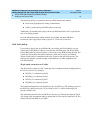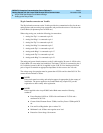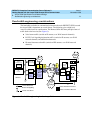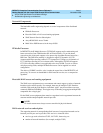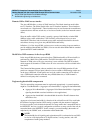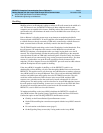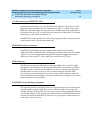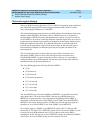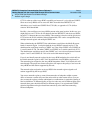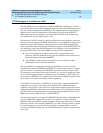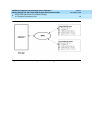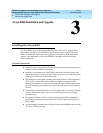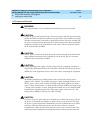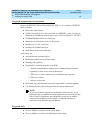
DEFINITY Enterprise Communication Server Release 9
Getting Started with the Avaya R300 Remote Office Communicator
Issue 1
November 2000
Avaya R300 Specifications and Network Design
26Network region design
2
Network region design
The Avaya R300 can receive data from a T1, E1 or BRI line (depending on the model) and
pass information through PSTN trunks, through drop/insert trunks (on the T1 model,
only), and through the Ethernet to a LAN/WAN.
The switch administrator can assign the Avaya R300 within a Network Region in the same
manner as other DEFINITY IP resources such as a Media Processor are assigned to a
Network Region. DEFINITY permits the administrator to specify, by region, an ordered
set of CODECs to be used for connecting endpoints within the region and a set to be used
to interconnect an endpoint in the region to an endpoint in another region. Separate Avaya
R300 units within the same office, or in different offices that are close through an IP
network, may be assigned the same network region in order to share the same type of
interconnectivity. Endpoints in different regions may be assigned with limited or no
interconnectivity.
The use of network regions can insure that intra-region office connections use a
high-quality CODEC with low delay while inter-region office connections use a
low-bandwidth CODEC to conserve network resources. However, it is reasonable to
configure multiple Avaya R300 endpoints into the same region if they share sufficient
network interconnectivity among themselves.
The Avaya R300 supports the following IP audio CODECs:
■ G.729
■ G.729 Annex A
■ G.729 Annex B
■ G.729 Annex A/Annex B
■ G.711 A-law 64k
■ G.711 A-law 56k
■ G.711 u-law 64k
■ G.711 u-law 56k
The Avaya R300 always advertises CODECs to DEFINITY at registration time in the
order shown above. The order of the CODECs that the Avaya R300 advertises to
DEFINITY at registration time is more important in determining which CODEC is
selected for a call than the order of the CODECs in the CODEC set on the DEFINITY.
DEFINITY will always attempt to utilize a CODEC at or near the top of an endpoint’s
capability set, even if that CODEC is low in the CODEC set on DEFINITY.
For example, suppose a CODEC set on DEFINITY consists of G.7111 Mu-law 64K,
followed by G.729, and G.723.1. DEFINITY would select G.729 for the CODEC on a call
involving an Avaya R300 endpoint since G.729 is at the top of the Avaya R300’s
capability set. In fact, the only way to force DEFINITY to select one of the other CODECs
over G.729 is to have a CODEC set that does not include G.729 at all.



